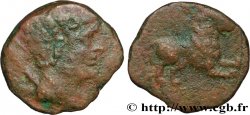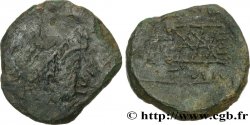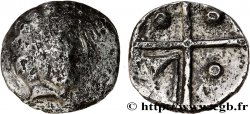v24_0862 - GALLIA - SOUTH WESTERN GAUL - LONGOSTALETES (Area of Narbonne) Drachme “au style languedocien”
MONNAIES 24 (2005)
Starting price : 200.00 €
Estimate : 500.00 €
Realised price : 200.00 €
Starting price : 200.00 €
Estimate : 500.00 €
Realised price : 200.00 €
Type : Drachme “au style languedocien”
Date: IIe siècle av. J.-C.
Metal : silver
Diameter : 15,5 mm
Orientation dies : 8 h.
Weight : 3,56 g.
Rarity : UNIQUE
Coments on the condition:
Flan arrondi ; types assez frustes au droit comme au revers. Belle patine homogène et irisée
Predigree :
Cet exemplaire provient de la vente Poindessaut de juin 1976 et de la collection de Georges Savès
Obverse
Obverse legend : ANÉPIGRAPHE.
Obverse description : Tête à gauche, le dessin fruste, avec la hache à peine visible au milieu du visage et le trait reliant le nez.
Reverse
Reverse legend : ANÉPIGRAPHE.
Reverse description : Croix formée de quatre cantons ; besant au 1er canton ; trois globules alignés aux 2e et 4e cantons ; hache évidée à gauche au 3e canton.
Commentary
Contrairement à la monnaie précédente, la hache du droit est assez peu perceptible. Le rapprochement au type Savès n° 288 est indiscutable, mais le revers de cette monnaie est absent de la série V et semble complètement inédit. Au lieu d'avoir un globule aux 1er, 2e et 3e canton, notre monnaie a un globule au 1er canton et un globule principal suivit de deux plus petits, dans les 2e et 4e cantons. Ce type de revers manque au Moneta 28.








 Report a mistake
Report a mistake Print the page
Print the page Share my selection
Share my selection Ask a question
Ask a question Consign / sell
Consign / sell
 Full data
Full data



